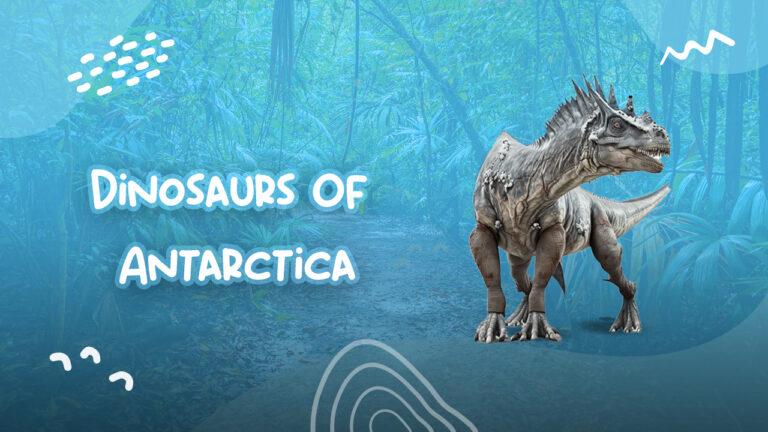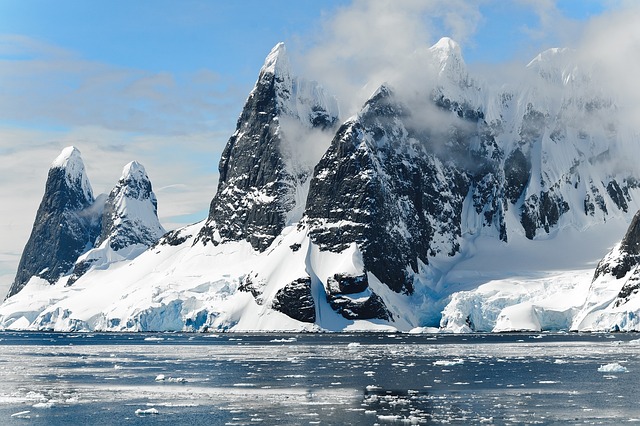Amazing Facts About Dinosaurs Of Antarctica

Despite its inhospitable climate, Antarctica was once home to a variety of dinosaurs. Dinosaurs of Antarctica have fossils, including the small, two-legged theropod Cryolophosaurus and the large, four-legged sauropod Glacialisaurus.
These dinosaurs of Antarctica lived during the Early Jurassic period, which was about 200 million years ago. It is believed that these dinosaurs lived in the warmer, wetter parts of Antarctica, which were located near the coast. This article about the dinosaurs of Antarctica will give an overview of its history and the dinosaurs found in this frozen land.
History of Dinosaurs of Antarctica
The history of dinosaurs in Antarctica reveals a past where this now icy continent was teeming with life, including a variety of dinosaur species. These discoveries, part of the broader narrative of the dinosaurs of Antarctica, offer a glimpse into a prehistoric ecosystem far different from today’s frozen landscape.
Discovery of Dinosaur Fossils
The first discovery of dinosaur fossils in Antarctica was made in the early 1900s. In 1911, a German expedition led by Wilhelm Filchner discovered a fossilized bone fragment of a theropod dinosaur in the Antarctic Peninsula. This was the first evidence of dinosaurs in Antarctica, and it was followed by further discoveries in the 1920s and 1930s.
In the late 1940s, a British expedition led by Vivian Fuchs discovered more dinosaur fossils in the Antarctic Peninsula. These fossils included bones from a sauropod dinosaur, as well as a partial skeleton of a theropod dinosaur. In the 2000s, a joint American-Argentine expedition discovered more dinosaur fossils in the Antarctic Peninsula. These fossils included bones from a theropod dinosaur, as well as a partial skeleton of a sauropod dinosaur.
Types of Dinosaurs Found
The types of dinosaurs of Antarctica include theropods, sauropods, and ornithopods. Theropods are carnivorous dinosaurs including the famous Tyrannosaurus rex. Sauropods are large, long-necked herbivorous dinosaurs, such as the Diplodocus. Ornithopods are small, bipedal herbivorous dinosaurs, such as the Iguanodon.
The fossils found in Antarctica are mostly fragmentary, so it is difficult to determine the exact species of dinosaurs that lived there. However, the fossils that have been found suggest that the dinosaurs that lived in Antarctica were similar to those found in other parts of the world.
What Dinosaurs Lived In Antarctica?
Antarctica is a continent that is known for its extremely cold temperatures and harsh environment. It is also home to some of the most fascinating creatures on Earth, including dinosaurs.
These Dinosaurs are not as common as in other parts of the world. The types of dinosaurs that lived in Antarctica include Cryolophosaurus, Antarctopelta, Antarctosaurus, and Glacialisaurus.
Dinosaurs of Antarctica–Cryolophosaurus
Cryolophosaurus, one of the notable dinosaurs of Antarctica, is a genus of large theropod dinosaurs that lived during the Early Jurassic period. It was first discovered in Antarctica in 1991 and is the only known dinosaur from the continent. Cryolophosaurus was a large carnivore, measuring up to 6 meters in length and weighing up to 1.5 tons. It had a distinctive crest on its head, which was likely used for display purposes.
Dinosaurs of Antarctica–Antarctopelta
Antarctopelta, one of the notable dinosaurs of Antarctica, is a genus of ankylosaurid dinosaur that lived during the Early Cretaceous period. It was first discovered in Antarctica in 1986 and is the only known ankylosaurid from the continent. Antarctopelta was a medium-sized herbivore, measuring up to 4 meters in length and weighing up to 1 ton. It had a distinctive armor plating on its body, which was likely used for protection from predators.
Dinosaurs of Antarctica–Antarctosaurus
Antarctosaurus is a genus of sauropod dinosaur that lived during the Late Jurassic period. It was first discovered in Antarctica in 1991 and is the only known sauropod from the continent. Antarctosaurus was a large herbivore, measuring up to 15 meters in length and weighing up to 10 tons. It had a long neck and tail, which were likely used for reaching food in the treetops.
Dinosaurs of Antarctica–Glacialisaurus
Glacialisaurus, one of the notable dinosaurs of Antarctica, is a genus of ornithopod dinosaur that lived during the Early Cretaceous period. It was first discovered in Antarctica in 1986 and is the only known ornithopod from the continent. Glacialisaurus was a medium-sized herbivore, measuring up to 4 meters in length and weighing up to 1 ton. It had a distinctive beak, which was likely used for grazing on vegetation.
These four types of dinosaurs are the only known dinosaurs from Antarctica. They provide us with a unique insight into the ancient world and the creatures that once roamed the continent. Although they are not as common as in other parts of the world, these dinosaurs are an important part of the history of Antarctica.
Climate and Environment of Antarctica
The Mesozoic Era of Antarctica is a period that lasted from 252 million years ago to 66 million years ago. It is the middle period of the three major divisions of geologic time, the other two being the Paleozoic and Cenozoic Eras. During this time, Antarctica was a part of the supercontinent Gondwana, which also included South America, Africa, India, and Australia.
Mesozoic Era
The Mesozoic Era of Antarctica was a time of great change and evolution. During this period, the climate of Antarctica was much warmer than it is today, and the continent was covered in lush vegetation. This warm climate allowed for the evolution of many species of plants and animals, including dinosaurs. The first dinosaurs of Antarctica appeared during the Middle Triassic period, and by the end of the Mesozoic Era, Antarctica was home to a variety of dinosaur species.
In Summary
Since the Triassic period, dinosaurs of Antarctica have roamed, leaving behind a diverse fossil record including theropods, sauropods, ornithopods, and ankylosaurs. The dinosaurs of Antarctica played a crucial role in shaping the continent’s landscape and influenced the evolution of other regional species.
Discoveries of these fossils underscore the dramatic changes Earth has undergone, highlighting a time when Antarctica’s environment was vastly different, supporting a rich diversity of dinosaur life. Despite today’s harsh conditions, the adaptability of dinosaurs of Antarctica during the Mesozoic Era is a testament to their resilience and evolutionary success in varying climates.
More discoveries and fun facts can be found at Dinosaurzus, make sure to check those out!

Top posts
related articles
Discover the Awesome Top 10 Longest Dinosaur Names
Dinosaurs, the ancient giants that once roamed the Earth, continue to capture our imagination. While
Discover the Amazing Dinosaur with 500 Teeth
Dinosaurs have always fascinated us with their colossal size, unique features, and intriguing mysteries. One
The Acheroraptor: An Insight into a Tiny but Fierce Dinosaur
The dinosaur world is undoubtedly fascinating, and the relative discovery of the acheroraptor is no
Epic Tale: Cryolophosaurus, Rise of the King
Cryolophosaurus, also known as the ‘Antarctic King’, was a fierce and fascinating dinosaur that existed
Torosaurus: The Horned Dinosaur with a Mysterious Identity
Dinosaurs don’t exist anymore, but their fossils still fascinate us. Paleontologists scour the earth to
Exploring the Wondrous World of Corythosaurus
The world of dinosaurs never stops fantastic us. From the huge T-rex to the tiny


